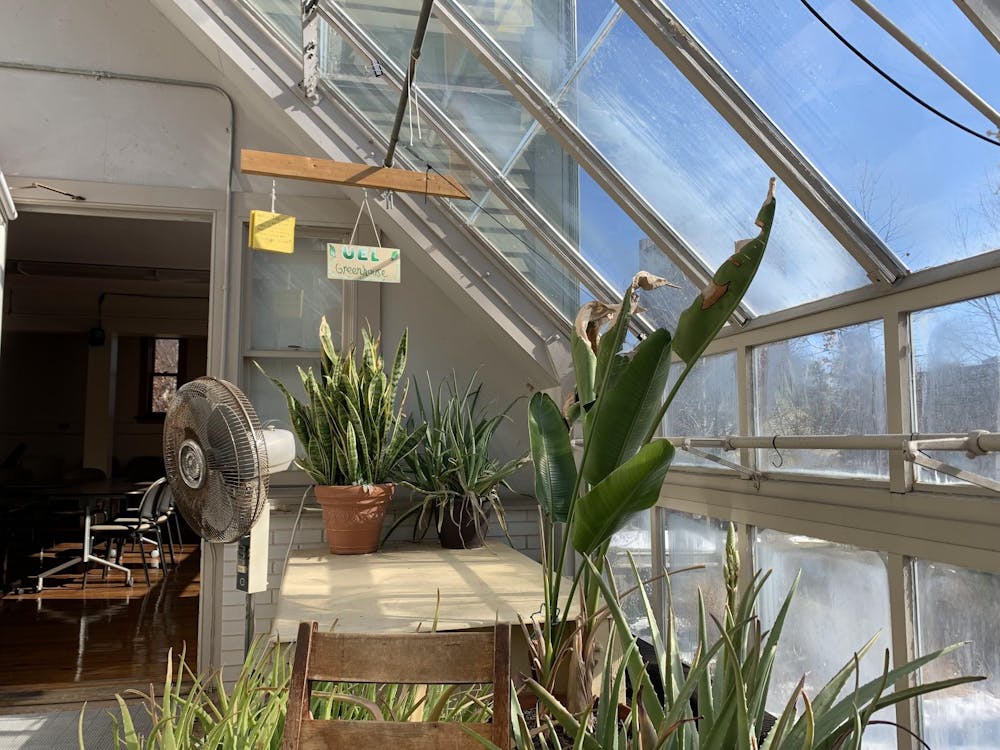Laughter radiates from the kitchen as students sit in the greenhouse to study. Professors and students mingle while making coffee. Environmental groups hold planning meetings. The Urban Environmental Lab, home to the undergraduate education component of the Institute at Brown for Environment and Society, is like nowhere else on campus.
Positioned in the heart of campus near the corner of Angell and Brown streets, the UEL has served as a community gathering place for environmentally minded students and faculty alike.
In recent years, the Lindemann Performing Arts Center — the subject of fanfare and national attention alike — has overshadowed its across-the-street neighbor, literally and figuratively. The Lindemann, in fact, nearly led to the demolition of the UEL before a concerted campaign saved the building.
As the Lindemann welcomes visitors, The Herald looked through its archives to revisit the UEL’s tumultuous history and understand why it still stands today.
In 1979, the University’s Center for Environmental Studies proposed converting the then-94-year-old Lucian Sharpe Carriage House into the UEL to create an “alternative technology laboratory,” according to the University’s 1979 grant proposal to the U.S. Department of Energy, The Herald reported at the time. Members of the Center for Environmental Studies wanted the UEL to be a space to explore ideas from solar technology to experimental food production.
Plans for the space included meeting rooms, a library and offices for the Center for Environmental Studies. Spaces for the living quarters of five students were also built. By living at the UEL, these students committed themselves to a sustainable lifestyle and attempted to “practice what the UEL preaches: conserving food, water and electricity” through efforts such as growing the majority of their own food in the building’s greenhouse.
In 1981, Brown’s plans became reality with a grant from the Richard King Mellon Foundation and construction began at 135 Angell St. At the time, students were deeply involved with the project, with more than 45 students even serving as construction workers for the building as an on-campus job.
Not everything in the construction process went as planned.
In 1982, a student construction worker fell from the roof of the UEL, sustaining serious injuries. And in January 1983, Brown ran into a $250,000 gap in construction funds, temporarily halting construction altogether.
The University eventually found funding and the UEL opened Nov. 11, 1983, The Herald reported at the time.
Since then, the UEL has remained beloved by students and faculty alike, creating an environment where students and professors interact in a building that many describe as a home.
“This building just continues to be for me, this living lab,” said Kurt Teichert, senior lecturer in environment and society. “This building is just a physical manifestation of who I am and what I do.”
Teichert has been at Brown since 1992 and experienced the earlier years of the UEL when students shared meals and research every Thursday with environmentally focused faculty and concentrators.
While the department has grown since then, the UEL still continues to be “the cultural and community home for the students in the undergraduate program,” Teichert said.
The UEL at risk
Twice in the last 20 years, the University has proposed the demolition of the UEL. Twice, those proposals were met with vocal community opposition.
In 2006, the University identified the UEL site as a location of potential construction, and UEL staff were told that the building wouldn’t exist in 10 to 15 years, The Herald reported at the time.
In 2007, the University announced plans to construct the Mind, Brain and Behavior building on the site. Students, staff and alumni were furious.
“Its destruction represents a short-sighted and, dare I say, stupid decision on the part of the University,” Laura Genello ’07 wrote in a Herald op-ed at the time.
The University offered to move the environmental studies department to another location on campus, but many believed that the new space wouldn’t create the same atmosphere. Students and staff tried to advocate for moving the building, but the University found that it would be too expensive and that there was no lot to which it could reasonably move.
Eventually, the University decided the building could be moved to Orchard Park, a beloved community green space, The Herald reported at the time. The community was at odds: They didn’t want the UEL or Orchard Park to be destroyed. Plans for the new building were eventually scrapped in 2009, in part due to financial concerns.
In 2017, the UEL again faced a threat for the proposed construction of the Lindemann.
The University planned to demolish the UEL along with four other buildings to make space for the performing arts center. In protest, Jon Gewirtzman ’17 and Lauren Manus ’19 created a “Save the UEL” petition, garnering campus support and over 300 signatures.
“When I thought we were going to get demolished, I was coming into work and just crying because I just thought (the UEL) was so special,” said Jeanne Loewenstein, academic program manager for the environmental studies and environmental science concentrations and the UEL’s caretaker.
Public protest delayed the first vote on the project proposal. An op-ed defending the UEL, advised by the Providence Preservation Society, was a “turning point” in saving the building. Brown soon after announced that the Lindemann would be situated where it stands today — demanding the movement of Sharpe House from Angell Street to Brown Street.
Many people assume Teichert hates the Lindemann Performing Arts Center, he said — an incorrect assumption.
“It’s an engineering and architectural marvel,” Teichert said. “It’s just that there were a lot of resources spent trying to put it in an inappropriate place to begin with, and the disruption to me, my work and our program — I’m not happy about that (but) I’m glad we’re still here.”
‘Built to be a home’
Much has changed since the UEL’s inception 40 years ago. Students no longer live in the building and some of its once-revolutionary technology is wearing, according to Teichert and Loewenstein.
Both Teichert and Loewenstein said they are deeply appreciative of the UEL but recognize that the building is due for some upgrades such as window replacements, adding solar panels and upgrading to a heat pump system.
With upgrades on the horizon, Loewenstein said she hopes that the UEL’s charm will stay intact. “A lot of times people are looking at what’s flashy … and not thinking about the fact that people are going to live in and work in these spaces,” she said, referring to some of the more unique features of the UEL, such as doors salvaged from construction sites.
Some “students … have told me that the UEL is what got them through their time at Brown,” Loewenstein said.
Charlie Usadi ’25 pointed to another beloved element of the UEL — the community garden that lies in front of the building. Previously a parking lot, the garden now has around 25 plots held by students, faculty and community members.
“It’s so special to have places like this in urban environments. They’re just a nice way to connect people to nature and bring (the) community together,” said Usadi, caretaker of the community garden. Usadi does everything from weeding to starting seedlings in the UEL’s greenhouse.
“One thing that makes me really happy is in the summer, people will consistently stop out front and take photos,” Usadi said. During this time, the raised beds are filled with strawberries, tomatoes, summer squash and wildflowers.
“I spend anywhere from 60 to 80 hours a week here,” Isabella Garo ’24 said. As the building is central to campus, she consistently works, attends class, spends time with friends and meets with Sunrise Brown, a climate organization on campus in the UEL. “It’s nice to have a building where you can do everything you need to do,” she said.
“It’s built to be a home,” Garo said, referencing the remnants of student housing you can see around the building, from showers in some of the bathrooms to offices being built as bedrooms. “I think that’s why people are so drawn to it,” she said. “It feels … like you’re coming home to a family.”
Clarification: This article has been updated to further specify the current use of the Urban Environmental Lab.

Cate Latimer is a university news editor covering faculty, University Hall and higher education. She is from Portland, OR, and studies English and Urban Studies. In her free time, you can find her playing ultimate frisbee or rewatching episodes of Parks and Rec.





